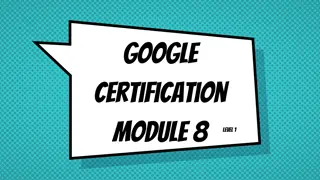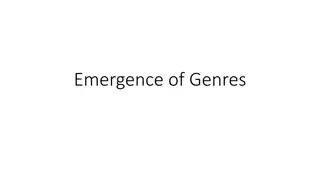Understanding Genre Forms, Text Features, and Structures in Reading, Writing, and Thinking
Explore the world of genre forms, text features, and structures in this engaging session. Learn to classify different texts, recognize generic features, and understand the main literary genres including prose, poetry, and drama. Delve into the nuances of prose writing, the musical quality of poetry, and the captivating storytelling in drama. Uncover the elements that bring these genres to life and enhance your reading, writing, and thinking processes.
Download Presentation

Please find below an Image/Link to download the presentation.
The content on the website is provided AS IS for your information and personal use only. It may not be sold, licensed, or shared on other websites without obtaining consent from the author. Download presentation by click this link. If you encounter any issues during the download, it is possible that the publisher has removed the file from their server.
E N D
Presentation Transcript
Genre forms, text features and structures INTRODUCTION TO READING, WRITING AND THINKING PROCESSES AND STRATEGIES ACROSS TEXT TYPES
Targets for this session Classify different texts according to types, genre and genre form. Recognize the generic features and structures of specific texts.
Defining Genre The term genre has been ordinarily regarded as a literary or artistic category.
Main Literary Genres Genre Prose Poetry Drama
Prose is writing that is similar to everyday speech and language. Its form is based on sentences and paragraphs. Fiction Non- fiction Characterized as being real, at least to some degree. A prose narrative in which situations and characters are invented by the writer. Examples: biographies, essays, autobiographies Examples: novels, novellas, short stories, myths, legends, fables and folktales
Poetry consists of language with a strong musical quality in which the words are highly charged with meaning. They also use structural elements such as line length and stanzas. Lyric poems are highly musical verses that express observations and feelings of a single speaker. Narrative poems are poems that tell a story. Epics are long narrative poems, written in dignified style, that celebrate the adventures and achievements of one or more heroic figures of legend, history, or religion. Ballads are songlike poems that tell a story, often dealing with adventure and romance. Free verse is poetry not written in regular rhythmical pattern, or meter. Sonnets are a form of rhyming lyric poetry with fourteen lines that follow an iambic pentameter rhyme scheme; each line has ten syllables and every other syllable is accented. Haiku is a special type of poetry from Japan, consists of seventeen syllables arranged in three lines, five syllables in the first line, seven in the second, and five in third.
Drama is a story told in dialogue by performers before an audience. It includes television and radio plays, and even movies. In drama, actors make a world come alive before an audience. Like fiction, the elements of drama include character, setting, theme and plot. Forms of Drama Comedy is a type of drama that has humorous and has a happy ending. Tragedy is a drama form in which the character, often a person of dignified or heroic stature, suffers a downfall. The downfall may result from outside forces of from a tragic flaw, a weakness within the character. A melodrama is a drama form that is full of exciting events and in which the characters and emotions seem to be too exaggerated to be real. A farce is a funny play for the theatre based on ridiculous and unlikely situations and events. A historical drama is a play that takes place in the past and is based on real events. In many of these plays, the characters are also based on real historical figures. The dialogue and action, however, are mostly created by the playwright.
Defining Texts Origin and Etymology of TEXT Middle English, from Anglo-French tiste, texte, from Medieval Latin textus, from Latin, texture, context, from texere to weave First Known Use: 14th century Wide range of definition Depends on the field or area it is associated Provides content, context and texture
Types of Text Text Types Literary Informational
Literary Texts Short stories Novels Poems Drama Biographies Essays Autobiographies
Informational Texts provide factual information. Consumer documents are printed materials that accompany products and services. They usually provide information about the use, care, operation, or assembly of the product or service they accompany. Public documents are documents written for the public to provide information that is of public interest or concern. Workplace documents are materials that are produced or used within a workplace. Their purpose is to aid in the functioning of a business. Academic texts like textbooks are materials used in school. Their purpose is to provide information needed to educate the students. Journalistic texts like newspaper articles provide readers with timely news, opinions and advertisements
Consumer Documents Applications Contracts Warranties Manuals Instructions Labels Brochures Schedules
Public Documents Government documents Speeches Signs Rules and Regulations Posters
Workplace documents Manuals Memos Reports Action Plan Proposals
Academic Texts Thesis Journal Articles Encyclopedias Research Reports Test Papers
Journalistic Texts Websites of Media Orgs Newspaper Magazine Social Media Accounts Surveys/ Polls
TEXT FEATURES ARE DESIGN ELEMENTS OF A TEXT THAT INDICATE ITS ORGANIZATIONAL STRUCTURE OR MAKE ITS KEY IDEAS AND INFORMATION UNDERSTANDABLE. The Universe of Texts TEXT STRUCTURES ARE PATTERNS OF ORGANIZATION OR DEVELOPMENT WRITERS USE IN ORGANIZING THEIR WRITING FOR A SPECIFIC PURPOSE.
Small Group Work (SGW) Examine the sample text to deduce the different text features. Analyze also the text structure.
Types of Text Features Body (Meat) Caption Signposts Headings /subheadings Questions Text features Boldface and Italic Type Bulleted and numbered lists, outline Graphic Aids or Organizers Illustrations Photos
Types of Organizational Patterns Cause- effect Compare and contrast Problem- Solution Text Structures Spatial Order Sequence/ Time Main Idea and Details
Point for Reflective Thinking: Freedom abounds with the limitless number of texts around us. Is this good or bad?
Assignment: Reflection Log No. 1 Freedom abounds with the limitless number of texts around us. Is this good or bad? Expound on the statement by discussing two important issues that may be sourced out from the said statement. Employ the skillful use of various text structures. Presentation of outputs is due for the next session.























